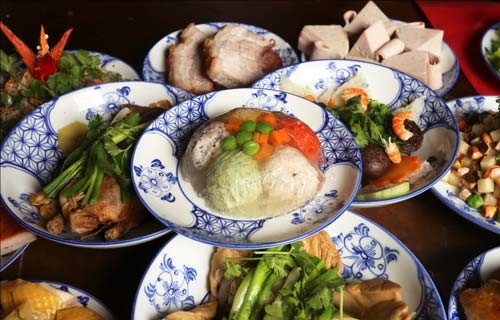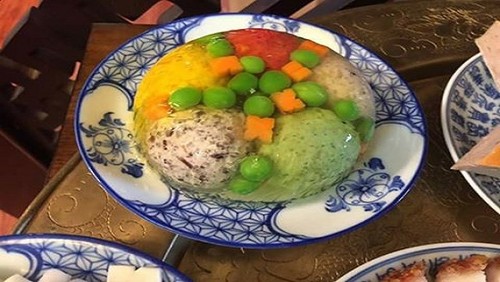You'r listening to Food Delight - The show for all you foodish out there
A: Hello and welcome to this week’s edition of VOV 24/7’s“Food delight”. We are …. and …, and we are very happy to be here to share our recipes with you.
B: Hello, A. Hello, you guys. Well, these days, driving in the streets, you can feel how close we are to Tet, the Vietnamese Lunar New Year. Even the smallest alleys have been beautifully decorated with flowers, red banners, and colored lights.
A: That’s right. Tet colors were the first things shining in my eyes when I woke up this morning. The golden kumquat trees, pink peach blossoms, and yellow apricot blossoms are showing off their beauty. And it seems like everybody is in a rush, the shopping for new clothes, decorating their houses, and, of course, preparing the traditional feast to offer their ancestors.
 |
Vietnamese traditional five-colored meat balls on Tet traditional tray of foods
(Source: Eva.vn)
|
B: Yeah. One of my favorite things about Tet is the feast. My mom usually cooks some amazing spring rolls, square sticky rice cakes, chicken soup, and Van am, which are five-colored meat balls. I’m so excited. I’m counting down not the days, but the hours before I go back home to enjoy all those Tet dishes.
A: Wow, your mom must be a great cook. But, that last dish you mentioned - the five-colored meat balls – sounds strange. Is it your mom’s own recipe?
B: Oh, no, A. The name may be unfamiliar to younger people, but it’s a very old Hanoi Tet tradition. I’ve had it, but I know nothing about how to make it. So, I’ve invited to the studio Hanoi cooking expert Nguyen Phuong Hai, who has spent years working to preserve the authentic taste of traditional dishes. He’ll show us how to cook this dish in the traditional way.
A: Oh, I can’t wait. Let’s hear Hai’s description of the dish. “In the past, five-colored meat balls was a dish for the upper class because it took time, patience, and many skills to make. The dish, a version of the familiar Jelly pork, was elevated to a higher level by mixing pork paste with different colors to create multi-colored meat balls floating beautifully in a bowl. The dish, which stood out in a Tet tray, was a nice offering by Hanoians to their ancestors.”
A: As I have learned from other traditional Vietnamese recipes that people often dyed their food using colors taken from leaves, fruits, and vegetables. For example, green might be taken from pandan leaves and red from magenta plants. Is that the case in this recipe?
B: You’re really good at remembering those small details, dear. But from the many kinds of leaves which can color food, we must choose ones that not only create beautiful colors, but also complementary flavors. Let’s hear Hai explain how to choose the colors to dye our meat balls. “The green is taken from Manh cong leaves, which are not only tasty but also good for human bones, especially for children and the elderly. The red is taken from baby jackfruit flesh, a rich source of vitamin A, which is essential in maintaining healthy eyesight. The yellow is taken from the dried Danh danh seed, which is also a kind of medicinal plant. Tthe black is created by mixing black wood-ear and mushrooms together. Mix the pork paste with the prepared colors and steam all the balls until well-cooked.”
A: The way Hanoians combine ingredients to make the dish is complicated. Manh cong leaves, Danh danh seeds, baby jackfruit flesh, and wood-ear. Wow, the dish is not only healthy but also eye-catching with many colorful meat balls arranged artistically in a bowl.
 |
| With their skilled hands, Hanoians combine familiar ingredients to create a colorful dish which embodies the spirit of Vietnam’s capital city (Source: Congly.vn) |
B: That’s right. For decoration, you can put boiled peas and carrots cut into flowers at the bottom of the bowl, and carefully arrange the meat balls on them before pouring enough the pig-skin stock to cover the meat. After about 5 hours in the refrigerator, the dish is ready to serve. Tip the jellied content of the bowl onto a flat plate and serve the beautiful five-colored jelly meatball cake to your delighted guest. “With their skilled hands, Hanoians combined familiar ingredients to create a colorful dish which embodies the spirit of Vietnam’s capital city. The custom of preparing Tet foods with five colors derives from the Asian belief in the five elements’ water, fire, wood, metal, and earth. So, the five-colored foods represent people’s hope for prosperity, good luck, good health, and happiness in the upcoming year.”
A: Tet is a special time of family reunion, a time for family members to gather and enjoy a warm atmosphere together. When Tet approaches, wherever they are, even thousands of kilometers from home, Vietnamese people feel an urge to reunite with their family for the three days of Tet. On this special occasion, we wish you a Happy New Year and hope that you will experience many blessings in the year to come.
B: And now, good bye. We’ll catch you next year on VOV24/7’s Food Delight. We’re A and B saying “Happy New Year” to all you guys.